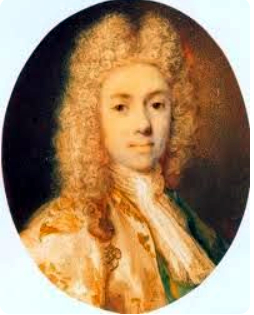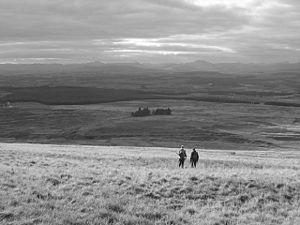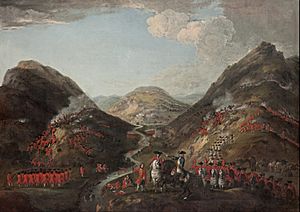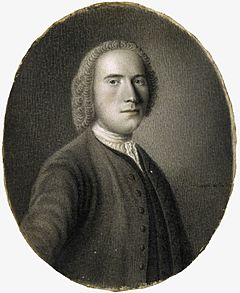William Murray, Marquess of Tullibardine facts for kids
Quick facts for kids
Marquess of Tullibardine
|
|
|---|---|

William Murray, Marquess of Tullibardine, styled Jacobite Duke of Atholl and Rannoch
|
|
| Personal details | |
| Born | 14 April 1689 Edinburgh |
| Died | 9 July 1746 (aged 57) Tower of London |
| Resting place | Church of St Peter ad Vincula |
| Nationality | Scottish |
| Parent |
|
| Alma mater | University of St Andrews |
| Occupation | Landowner and soldier |
| Military service | |
| Years of service | 1707–1712 (Royal Navy) 1715–1719 & 1745–1746 (Jacobite) |
| Rank | Lieutenant (Royal Navy) Lieutenant General (Jacobite) |
| Battles/wars | |
William Murray, Marquess of Tullibardine (born 14 April 1689 – died 9 July 1746) was a Scottish nobleman. He was a Jacobite, meaning he supported the return of the Stuart family to the throne of Great Britain. He took part in three major rebellions against the ruling king.
Because of his role in the 1715 rebellion, he lost his right to inherit his family's titles. His younger brother, James, became the Duke of Atholl in 1724. William was given the title Duke of Rannoch by the Jacobites, but this was not recognized by the government. After the 1719 rebellion, he lived in France for 25 years. He faced great poverty and struggled with his health.
Despite his difficulties, he was one of the Seven Men of Moidart. These were the people who came with Prince Charles (also known as Bonnie Prince Charlie) to Scotland in July 1745. Another of his brothers, Lord George Murray, became an important leader in the Jacobite army. William was captured after the Battle of Culloden in April 1746. He died in the Tower of London on 9 July of that year.
Contents
Who Was William Murray?
William Murray was born on 14 April 1689. His birthplace was Huntingtower, near Perth, Scotland. He was the second son of John Murray, 1st Duke of Atholl. His mother was Katherine Hamilton. William was one of more than 20 children in his large family.
When his older brother, John, died in 1709, William became the Marquess of Tullibardine. This meant he was next in line to become the Duke of Atholl. However, after he joined the 1715 rebellion, he was attainted. This legal action meant he lost his right to inherit the title. So, in 1724, his younger brother, James, became the 2nd Duke of Atholl instead. William never married or had children.
William studied at the University of St Andrews. In 1707, he joined the Royal Navy. This decision was apparently against his father's wishes. He served under Admiral George Byng during the War of the Spanish Succession.
In 1712, he left the navy and moved to London. He soon started having money problems, which continued throughout his life. By 1714, he was getting money from the Stuart family, who were living in exile in France.
The Jacobite Rebellions
The 1715 Rebellion
In August 1714, Queen Anne died. She was succeeded by George I, a Protestant from Hanover, Germany. Many people, known as Jacobites, wanted Anne's Catholic half-brother, James Francis Edward, to be king instead.
In June 1715, the Earl of Mar started a rebellion in Scotland. William's father, the Duke of Atholl, did not support this rebellion. He warned his sons not to join, or he would disinherit them.
Despite his father's warning, William and his brothers Charles and George joined the Jacobite army. Their father blamed Lady Nairne, a strong Jacobite, for influencing them. However, other sons of the Duke fought for the government.

William commanded the left side of the Jacobite army at the Battle of Sheriffmuir on 13 November 1715. The battle was confusing and did not have a clear winner. However, it was a strategic defeat for the Jacobites. Without more support, the rebellion soon failed.
William's brother Charles was captured and sentenced to death but was later pardoned. William and George were forced to leave the country. William was attainted, meaning he lost his legal rights and titles. His younger brother James became the new heir to the dukedom.
The 1719 Rebellion
After the 1715 rebellion, the Murrays tried to get support from Sweden for another invasion. This plan became part of the 1719 Rebellion. The main plan was for Spain to land troops in England. A smaller group would land in Scotland to capture Inverness.
William and Lord George arrived in Stornoway in April 1719. They met other exiles and 300 Spanish marines. However, only the Scottish part of the rebellion actually happened.

The rebellion ended after the Jacobites were defeated at the Battle of Glenshiel on 10 June. William was wounded in the battle, as was Lord George. Despite large rewards offered for their capture, both brothers managed to escape again.
After this failure, William believed that a Stuart king could only return if there was also a landing in England, not just Scotland. He wrote that their efforts were "unreasonably" brought about and would "ruin the Kings Interest." Many senior Jacobites were allowed to return home, but William remained in exile.
Exile and the 1745 Rebellion
When their father died in 1724, James became the Duke of Atholl. In 1717, the Jacobites had given William the title Duke of Rannoch. He was also sometimes called Duke of Atholl by Jacobite supporters. Lord George accepted a pardon and returned home in 1725. William, however, stayed in Paris.
Details about William's life in exile are not very clear. In a letter from 1723, he said he was "unfit" for important matters of state and wanted to live a private life. It seems he suffered from both physical and mental health problems. He was also constantly short of money, even with financial help from his family in Scotland.
A report from 1731 said William had to sell his horse because he couldn't afford to feed it. It also mentioned he only had a simple "highland dress" and a "dressing gown" to wear. His house looked more like a hideout for robbers than a nobleman's home. In 1733, he was arrested for not paying a large wine bill. He was imprisoned for debt in 1736 but was released in 1737. He then went to live with a priest in France.

In the 1745 Rising, William was one of the Seven Men of Moidart. These men sailed with Prince Charles to Scotland. William suffered from gout and looked much older than his 58 years. People noted he "could scarce write his own language."
Despite his health, William was very important to the Jacobite cause. Many of the Atholl tenants saw him as the true duke, not his brother James. This helped a lot with recruiting new soldiers. His presence might also have encouraged Lord George Murray to join the Jacobite army.
William returned to Blair Castle for the first time in 30 years. He was made commander of Jacobite forces north of the Firth of Forth. In October, he arrived in Edinburgh with about 600 new recruits. These men formed the "Duke of Atholl's Regiment," which later became the "Atholl Brigade."
William went with the Jacobite army when they invaded England in November. After they retreated from Derby, he returned to Perthshire to gather more men. Highland soldiers often went home in winter, and many men left the Atholl Brigade. Lord George urged William to make examples of deserters to keep the army together. William and his agents reportedly used threats to ensure people joined and did not leave.
Capture and Death
William rejoined Prince Charles at Culloden House in February 1746. Soon after, government forces took over Blair Castle. After the battle of Culloden in April 1746, William managed to escape with a servant. However, his age and health problems made it very hard for him to ride a horse.
On 27 April, they reached Ross Priory in Dumbartonshire. William was too sick to go any further. Government troops captured him there. He did not arrive at the Tower of London until late June. His health had gotten even worse. He died there on 9 July 1746, before he could be put on trial. He was buried in the Church of St Peter ad Vincula.

